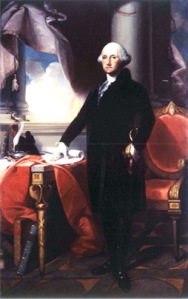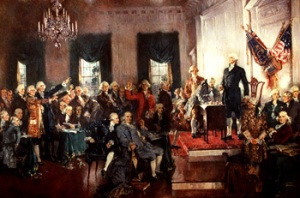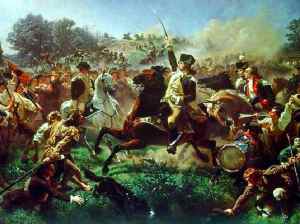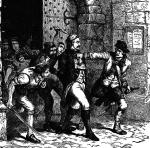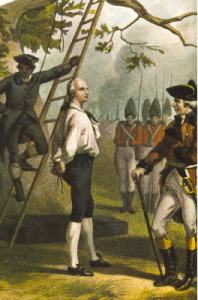Rosicrucian Digest claims that, “the Rosicrucian Order was the only society of its day which offered the services of its total membership to the shaky cause of liberty…Ephrata was the only American community to mobilize exactly 100% for the rehabilitation of the fallen.”
The Continental Congress pressed various religious communities to provide medical assistance during the Revolution. Unlike other groups, Ephrata did not ask for any reimbursement for their contributions and sacrifices, including the destruction of their homes and tabernacle; depletion of food stores, clothing, blankets, medical supplies, and trade inventories; the loss of priceless works of art and, in several cases, their lives. Steadfast pacifists, the brethren and sisters of Ephrata abhorred the war and refused to take up arms but, by acquiescing to the request from George Washington to tend to the wounded and dying of the Continental Army, they exposed themselves to the deadly typhus and smallpox infecting the troops.

Battle of Brandywine
Although the medical facilities at Ephrata became, per Army records, the “principal hospital for the sick and severely wounded at Brandywine,” the Pietist and Rosicrucian cloister’s participation in the Revolution neither begins nor ends with dressing the wounds suffered at the Battle of Brandywine.
Several among this commune of pacifist monks and sisters were not long out of hermetic caves in Cocalico or along the banks of the Wissahocken. To understand why Ephrata ultimately not simply accepted its fate, but embraced its role in the Revolutionary War, we have to look at why Ephrata was founded and, similarly, why its predecessor, Woman in the Wilderness, America’s first commune, crystallized around Johannes Kelpius.
Cynics might point out that Ephrata became a hospital because George Washington said it must and, indeed, he did. He offered Peter Miller, Ephrata’s spiritual leader, no true choice. The cloister was commandeered. Community members, riled, objected; some of them had been hermits but, when the topic turned to religion or government, they proved tenacious and argumentative. Intellectually, they were neither meek nor mild. They debated. Passively resisting the war machine, they insisted that the army take what it needed by force. They knew they would suffer severe material loss, and sacrifice the routines of their spiritual lives to tend to the immediate physical needs of others. They knew such service might kill them. In the end, the commune embraced its role. What looked from outside the commune like a seizure of property and the conscription of a hospital staff was transformed by the adepts of Ephrata into the work of the spirit, until it became, from within, an offering and a devotion to holy service.
As one soldier, grateful for the healing and soothing from the sisters of Roses

View on the Wissahickon by James Peale
of Sharon said,
“Until I entered the walls of Ephrata, I had no idea of pure and practical Christianity. I knew it in theory before; I saw it in practice then.”
William Penn, Heretics, and the New World
In New Atlantis, Sir Francis Bacon writes of Bensalem, a place where “generosity and enlightenment, dignity and splendour, piety and public spirit” will reign. Bensalem inspired the founders of the Royal Society of London. At roughly the same time, the mid to late seventeenth century, Quakers in England were deported, imprisoned, or worse.
William Penn, a pacifist Quaker, was more or less paid off by King Charles II to round up all the heretics he could, haul them away from England and, for good measure, everywhere else in Europe, and drop them in America. Between what Quakers already owned and controlled of East and West Jersey, and the new grant to settle the debt of the Crown, Quakers controlled West Jersey and Pennsylvania.
Upon receipt of his charter, Penn wrote, “It is a clear and just thing, and my God who has given it me through many difficulties, will, I believe, bless and make it the seed of a nation,” a major tenet of which would be spiritual tolerance and the freedom to worship as one sees fit. Penn’s promotional literature, proselytizing tours through Europe, and Frame of Government emphasized religious freedom and open discourse, offering, at least in theory, the power to the populace to actively influence government.
Among Penn’s favorite regions in which to recruit were the Rhinelands and Lowlands of Germany. Penn extended invitations to all German Quakers, and he proved especially attractive to the Pietists. Francis Daniel Pastorius secured land from Penn, and the two collaborated on a plan for a “Germanopolis”– Germantown. Pastorius soon led a modest wave of Pietist immigration from Germany to Pennsylvania.
Aside from escaping persecution, the Pietists came because they thought that Europe and the Church were suffering the death rattles of unregenerate and irreversible spiritual decay. The Pietist groups were attracted by the promise of a true New World, one in which Christianity could be recalled from the profligate, restored, purified to the point that Christ, the Bridegroom, would return. Casting their eyes upon the old world, the Pietists marked the signs of the Apocalypse. Divine Judgment was imminent. The Pietists, like Noah, built an ark and sailed for a new land in which they could live rightly and be spared holy retribution. Distancing themselves from the old world, full of sin, they congregated in dens of peace and brotherhood to facilitate rediscovery of the truth long trampled by moral decline.
Cocooning in the Wilderness
Ten years after the founding of Germantown, a group of Pietists, who were also third-degree Rosicrucian adepts, took root in huts and caves on the ridge above the Wissahickon. Johannes Kelpius and his followers thought of themselves as the Chapter of Perfection. By “perfection,” Kelpius was referring to their task of “completing” a spiritual journey. In no way did the “monks of the ridge” regard themselves as “flawless.” Today, we refer to Kelpius’ group as Woman in the Wilderness. The study of the history of communes and intentional communities in America is incomplete without an understanding of Woman in the Wilderness.

Johannes Kelpius
Johannes Kelpius left the Old World to find an unspoiled place in which, via study and prayer, he could prepare for the New Era. Mathematicians, theologians, astronomers, Kabbalists- Johannes Kelpius and forty fellow university scholars settled in the wilderness, on the spot, and during the year in which, they expected the Second Coming. By day, Kelpius and his brethren studied, worshiped, taught school, and plied trades: physician, architect, bookbinder, clockmaker. By night, they scanned the skies, eyes intent on the Millennium. The Bridegroom never arrived. However, the members of Woman in the Wilderness, learned men early in the Age of Enlightenment, were aware that they had come to a place of pure potential, a place where they could find the religious freedom and political rights essential to the world they wanted to inhabit and for which they were prepared to sacrifice.
In “The Messenger of the Magi,” published in the 1951 Rosicrucian Digest, Harold Preece writes,
Whatever the unrevealed purposes of the Masters, their intention had been clear choosing this young, new nation of the West as the place where majestic teachings would flower in august greatness. Here, eventually, free institutions would permit the free dissemination of noble, redeeming principles kept carefully guarded in older countries wracked by tyranny and torture. Here, truth would be left forever unchained to combat error through reason and logic. Here, seekers of the truth could be informed of the great Order, which waited graciously to serve them.
The hermits of the Wissahickon, the Pietists and Rosicrucians of Ephrata, all devout, skilled, intelligent, learned people, believed just as deeply as George Washington or any other of the founding fathers that America was a destination promised to the deserving. Like Washington, Adams, Franklin, and Jefferson, the “monks of the ridge” and the later cloister sensed that the power to determine history, the capacity to influence the evolution of humanity was in their grasp.
They approached from different angles, but the radical mystic Protestant theosophists of Ephrata and the evolving Enlightenment Age politicians of the emerging United States met at meaningful points.

Read Full Post »





